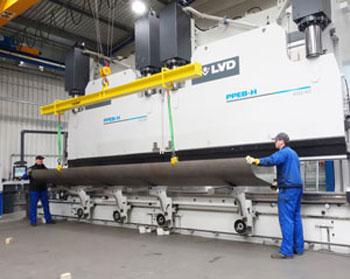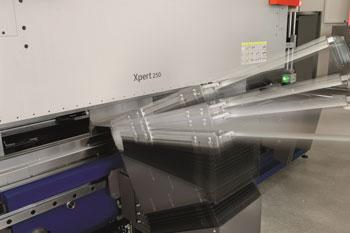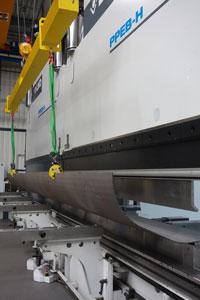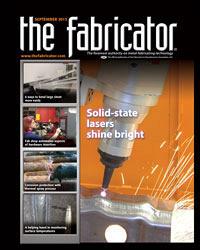Editor-in-Chief
- FMA
- The Fabricator
- FABTECH
- Canadian Metalworking
Categories
- Additive Manufacturing
- Aluminum Welding
- Arc Welding
- Assembly and Joining
- Automation and Robotics
- Bending and Forming
- Consumables
- Cutting and Weld Prep
- Electric Vehicles
- En Español
- Finishing
- Hydroforming
- Laser Cutting
- Laser Welding
- Machining
- Manufacturing Software
- Materials Handling
- Metals/Materials
- Oxyfuel Cutting
- Plasma Cutting
- Power Tools
- Punching and Other Holemaking
- Roll Forming
- Safety
- Sawing
- Shearing
- Shop Management
- Testing and Measuring
- Tube and Pipe Fabrication
- Tube and Pipe Production
- Waterjet Cutting
Industry Directory
Webcasts
Podcasts
FAB 40
Advertise
Subscribe
Account Login
Search
6 ways to make large-sheet-bending easier
Material handling and advanced controls help to make an awkward job more manageable
- By Dan Davis
- September 5, 2013
- Article
- Bending and Forming

Figure 1: Bending large panels in a press brake is not a one-man operation. However, material handling tools and advanced control technology can help make it a more efficient process. Photo courtesy of LVD Strippit.
Bending a large sheet in a press brake is never a one-person job (see Figure 1). In some instances, it can be a three- or four-person job. For some bending departments, that might translate to “all hands on deck.”
Of course, that fabricating scenario flies in the face of today’s manufacturing reality. Workforces at fabricating shops have been trimmed down to essential personnel. There aren’t a lot of extra people hanging around for the sole purpose of assisting with awkward bending jobs.
That’s why not too many shops can take on large-panel bending. The jobs aren’t huge in volume, and it takes the right press brake—with the appropriate tonnage, open height, and window width—to do the job correctly. Shops have emerged as specialists in this area.
Having said that, more fabricators are showing an interest in large-sheet bending. Some see the potential to diversify their customer base. Others simply want to get away from the welding required to join several smaller pieces together to create large forms.
Those metal fabricators involved in panel bending on a press brake or thinking about adding the capability should realize that material handling tools and advanced control technology have emerged over the years to assist with this big job. This type of fabricating operation doesn’t have to overwhelm a bending department.
No. 1: Get out in Front
It sounds like a no-brainer, but you don’t see front sheet supports on all press brakes in the U.S.
“At a minimum, front sheet supports allow you to rest the part, turn it around, or manipulate it more easily,” said John Kemp, manager of applications and training, Bystronic Inc.
Many fabricators that work with large panels might think they can get away without having such a permanent attachment on the press brake because volumes don’t warrant the investment. Instead, they might rely on a nearby table or some other ad-hoc material handling assist.
Kemp added that without a doubt front sheet supports can make the job easier for the press brake operator. In some instances, it also might mean that the operator can do the job without any assistance.
These supports can have different surfaces for specific jobs. For example, nylon inserts can be used for general-purpose bending and brush inserts for stainless steel work.

Figure 2: Sheet followers can be used to prevent back-bending of thin-gauge metal during the bending process and can help to free up labor when working with large panels. Photo courtesy of Bystronic Inc.
No. 2: Follow the Sheet
On thin-gauge panels, a large section of material protruding from the press brake window during a small flange bend can pose a problem. If left unsupported, the material back-bends, meaning the material bends in the opposite direction of the bend the press brake tooling is performing.
Most fabricators rely on multiple sets of hands to support these jobs, but sheet followers can free up this labor (see Figure 2).
“The sheet lifters do a good job with the thin material. They support it during the bending and bringing it back down,” said Paul LeTang, bending product sales manager, LVD Strippit.
If a fabricator is working with material nearing 0.1875 in. thick, the press brake operator probably doesn’t have to worry about using a sheet follower. At that thickness, the material is strong enough to support itself.
No. 3: Bring on the Crane
A more familiar sight in metal fabricating settings is the use of a crane (see Figure 3) for these awkward bending jobs in the press brake. Often cranes are a very cost-effective means to move the material to the press brake window for bending.
“One of the things that I would recommend are cranes near the machine or on it, both front and back. The parts are big and awkward, and having some kind of little, portable crane makes them quite easier to handle,” LeTang said.
It should be noted that typically cranes are not integrated into the control software. The press brake operator and potentially someone else helping with the material movement need to place the workpiece in the right position against the backgauge for the proper bend to take place.
No. 4: Push It
The world of utility pole manufacturing does not involve light-gauge steel, but it does involve a material handling option that is noteworthy: automatic positioners.
These positioners, also called pushers, move the workpiece according to directions from the press brake operator. This positioning aid introduces an element of exact movement in the press brake bed so that precise bump bends can be made to create poles out of sheets that might be 60 ft. long and 10 ft. wide.
The pushers “bring the plate in from the front, and the operator moves it forward with a joystick in increments. They bend the plate, and when they are done, they take it out with a crane and bring in the next one,” said Gordan Baker, vice president and director of product technology, Pacific Press Technologies.

Figure 3: Cranes are almost a necessity in certain large bending jobs. As a result, machine operators must maintain a heightened sense of awareness when using them to ensure worker safety and protect the material and machine from damage. Photo courtesy of LVD Strippit.
Even with the automated movement of the large workpiece across the die, this type of job usually involves two people anyway, Baker said. Because the sheet is so wide, the press brake operator is going to want to have someone at the end opposite of the control panel to ensure that the sheet is centered prior to the ram coming down.
“It’s just a mitigation of risk. That’s what the person is there for,” he said.
Camera technology can be used to check for proper positioning of a large workpiece before bending commences, allowing the job to be done by one person. That adds a lot of capital expense, however, which prevents fabricators from following up on that type of quality check, according to Baker.
No. 5: Control the Bending Speed
As parts get longer, a press brake operator and anyone assisting him have to worry about possible whip-up, in which the material outside of the press brake window quickly whips up as the material inside the press brake is bent in the die. Such a quick whipping action can startle and possibly injure someone responsible for handling the material, but who may not be totally engaged in the activity.
Luckily, most modern press brakes have programmable ram speeds, which means the large sheets can be bent at a much slower pace than small parts. The slower pace means that the longer part will not so much whip up as slowly rise up.
The same thinking applies to programming the speed of the ram in the up direction.
“So rather than fully releasing the part and having it drop, you can program it to go up at whatever rate you want. It can either set down the heavy part slowly or you can position yourself or the part manipulator to help with larger thinner sheets so they are not going to flex back when you release the brake,” Kemp said.
Newer press brakes also have angle correction to ensure that the first bend meets the original specifications for the job. This feature relies on lasers, sensors, or mechanical probes to check that the appropriate angle was made before the ram fully retreats to its starting position and the material is moved out of the press brake.
“The biggest advantage of this adaptive system is that you don’t have to rehit the part,” LeTang said. “Often on a press brake you make a trial hit, take it out of the machine, measure the angle, put it back in, make another hit, take it out, measure, and put it back in. Every time you take the part in and out of the machine, you have material handling issues. Every time you bring down the ram, you also run the risk of an error of maybe overbending the part or damaging it.”
No. 6: Control the Crowning
Any time a part is bent in a press brake, the machine is subject to deflection. As the press brake’s ram is driven down on both sides, the workpiece material acts as an impediment to the ram achieving its full downward cycle when compared to the sections of the ram unencumbered with material interference. This causes the ram to deflect in the vertical plane. When this occurs and the press brake operator does not address it, large parts run the risk of becoming canoe-shaped in the center.
Now press brake manufacturers could build a machine that doesn’t flex at all, but it would require an upper beam that is about 2 ft. thick. That’s not a machine that would interest a fabricator.
So, many manufacturers focused on automatic crowning. Since the 1990s, these press brakes, which employ a hydraulic system in the bed and precise control of the ram stroke to counter the deflection that results from any bend, have been the logical machine of choice for fabricators that had to deliver high-tolerance parts but didn’t have the highly experienced operators to guarantee good results on a consistent basis.
Automatic crowning adjustments are made on-the-fly as the bend is taking place. This advanced feature helps inexperienced operators deal with material factors such as tensile strength, grain direction, and hardness. These modern press brakes even make off-center bending an easy task; the press brake determines where the bending location is by measuring the pressure on each side of the bed, and the multiple crowning cylinders adjust accordingly to ensure a consistent bend angle.
“When those variables change, the machine has to adapt to those, or the operator would have to adapt by making corrections,” Kemp said.
Those operators who can be relied on—and are experienced enough—to adjust the crowning on older press brakes with the use of shims and knowledge found in a little black book are an extremely rare breed. Shops that do have that expertise, however, still can’t match the productivity of machines that can adjust crowning on-the-fly.
In the end, no fabricator is interested in scrapping a large panel of sheet metal that was bent incorrectly on a press brake. That’s an unacceptable result.
About the Author

Dan Davis
2135 Point Blvd.
Elgin, IL 60123
815-227-8281
Dan Davis is editor-in-chief of The Fabricator, the industry's most widely circulated metal fabricating magazine, and its sister publications, The Tube & Pipe Journal and The Welder. He has been with the publications since April 2002.
Related Companies
subscribe now

The Fabricator is North America's leading magazine for the metal forming and fabricating industry. The magazine delivers the news, technical articles, and case histories that enable fabricators to do their jobs more efficiently. The Fabricator has served the industry since 1970.
start your free subscription- Stay connected from anywhere

Easily access valuable industry resources now with full access to the digital edition of The Fabricator.

Easily access valuable industry resources now with full access to the digital edition of The Welder.

Easily access valuable industry resources now with full access to the digital edition of The Tube and Pipe Journal.
- Podcasting
- Podcast:
- The Fabricator Podcast
- Published:
- 04/16/2024
- Running Time:
- 63:29
In this episode of The Fabricator Podcast, Caleb Chamberlain, co-founder and CEO of OSH Cut, discusses his company’s...
- Trending Articles
AI, machine learning, and the future of metal fabrication

Employee ownership: The best way to ensure engagement

Dynamic Metal blossoms with each passing year

Steel industry reacts to Nucor’s new weekly published HRC price

Metal fabrication management: A guide for new supervisors

- Industry Events
16th Annual Safety Conference
- April 30 - May 1, 2024
- Elgin,
Pipe and Tube Conference
- May 21 - 22, 2024
- Omaha, NE
World-Class Roll Forming Workshop
- June 5 - 6, 2024
- Louisville, KY
Advanced Laser Application Workshop
- June 25 - 27, 2024
- Novi, MI


























